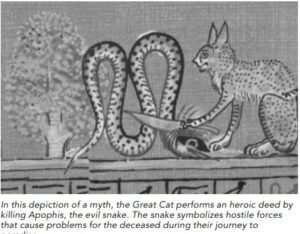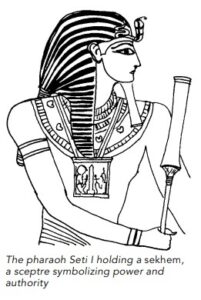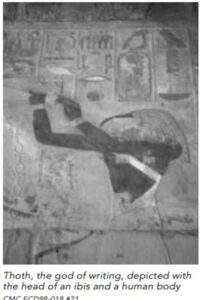The Egyptian Religion and Creation Myth
Myths are stories that become part of humanity’s collective memory. They
are said to represent the dreams of a society. It is possible to interpret them
from a variety of perspectives to explain natural phenomena, such as how the earth was formed. At another level, they are a rich source of insights
into society and human behavior.

Myths, particularly creation myths, have had a profound effect on ancient cultures. They form the foundation of religious beliefs that influenced all forms of cultural expression, as well as values and attitudes. Nowhere is this
truer than in Egypt.’
Myths are rich in symbolic meaning. Their settings may seem strange and their characters larger than life, but by learning to understand their meaning, we can unlock their secrets. Capable of amazing feats, such as changing shape, the characters in myths often represent aspects of human behaviors such as love and jealousy, or phenomena such as order and destruction.
The Evolution of Religion
One of the most interesting aspects of ancient Egypt is its religion. The depth of Egyptian thinking and the rich imagination displayed in the creation of ideas and images of the gods and goddesses are beyond compare.

In elaborating their beliefs, the Egyptians were searching for an understanding of the most basic laws of life, death and the Universe. They developed the first thought forms of the Godhead — the beginnings of a religion. Their beliefs evolved slowly over the centuries and gradually developed into a comprehensive world view shared by the people of the Nile.
Religion is the glue that binds local communities into nation hood and creates common understandings and shared values that are essential to the growth of a civilization. No religion is fully formed at its inception. By looking at ancient Egypt, one can see how belief systems evolved to become the driving force of cultural expressions. In the early stages of human thought, the concept of God did not exist. Our early ancestors were concerned about natural phenomena and the powers that controlled those phenomena; they did not worship a personalized form of God. This stage of religious development is referred to as “magical”
 In Egypt, before the concept of God existed, magical power was encapsulated in the hieroglyph of a scepters (or rod or staff). This is one of the most enduring symbols of divine
In Egypt, before the concept of God existed, magical power was encapsulated in the hieroglyph of a scepters (or rod or staff). This is one of the most enduring symbols of divine
power, ever present in images of the pharaohs and the gods.
As human society evolved, people gradually gained a degree of personal identity. With a higher sense of individuality, they began to conceive the gods in a personalized form. This stage in development is called “mythical”.
At that stage, every Egyptian town had its own deity, manifested in a material fetish or a god represented in the shape of an animal, such as a cat goddess, cobra goddess, ibis god or jackal god. As the pantheon grew in cohesiveness, these gods and goddesses were given human bodies and credited with human attributes and activities. 
The temples in the major cities throughout the land were constructed to venerate local gods. During the New Kingdom, these temples honored a triad of gods based on the pattern established by the mythical family of Osiris, Isis and Horus.
It is easy to get confused when trying to identify the Egyptian gods. There is a large number of them, and they are not always depicted the same way. There is a large number of them, and they are not always depicted the same way. For example, Thoth, the god of writing and messenger of the sun god, is seen
as a human with the head of an ibis, or as a baboon or the moon.
Like the Greek gods, the Egyptian gods symbolized aspects of life, human emotions and the physical world. Gods and goddesses are often grouped in pairs to represent the dual nature of life, the negative and positive forces of the cosmos. An example is Osiris, representing life and order, and Seth, representing disorder and destruction.
Like all religions, that of ancient Egypt was complex. It evolved over the centuries from one that emphasized local deities into a national religion with a smaller number of principal deities. Some theologians think that Egypt was moving towards a monotheistic faith in a single creator, symbolized by the sun god.
READ MUCH MORE INSIDE…
DOWNLOAD NOW
The Egyptian Religion and Creation Myth

Try it Risk Free Today!

Our 100% Money Back Guarantee:
If for any reason you decided within 30 days that “The Egyptian Religion and Creation Myth“ is not for you, simply notify us by email and we will gladly refund your money – no questions asked. That is our Ironclad Guarantee! The risk is entirely ours! You absolutely have nothing to lose!
Click on the Buy Button Below for Instant Access!

